It’s not often that one gets the opportunity to set fire to 25 acres of grass, brush and slash, but that’s what we got to do yesterday. “Why?” you might ask. Well …
An Oak Savannah is an area that typically has about 20 – 30 mature oaks per acre, with grass underneath. Untouched by humans, they generally burn every several years, reducing the grasses, encroaching evergreens and brush. The grass grows back, giving good cover and providing food sources for the wildlife. Once people enter the scene, the natural burns are reduced allowing the brush and evergreens to grow up, gradually crowding and ultimately destroying the oaks (and the habitat they provide). Oak Savannahs are also lost due to urban development or conversion to forestland.
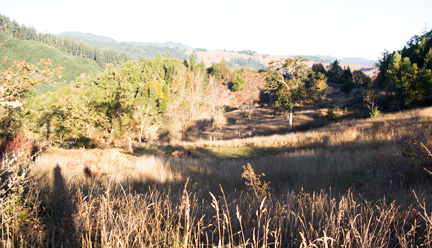
We are lucky to have a section on the ranch that’s classed as an Oak Savannah. It’s a particular type of habitat in Oregon and northern California that is important to a variety of wildlife, especially larger animals like elk and deer. In our area near the coast they are fairly rare. In fact, because Oak Savannahs are fast becoming sufficiently scarce all around, there’s a great deal of focus on getting them restored.
With the help and support (and some funding) from the National Resource Conservation Service (out of the USDA) and the Oregon Fish and Wildlife Access & Habitat program, we have been on a program to restore about 30 acres of Oak Savannah. This past summer we cleared the encroaching fir and brush. Of the trees that were felled, some of the wood has been set aside to be milled in our small sawmill and will be used for building projects as needed. The smaller parts have been cut as firewood which will provide heat for all 3 homes on the ranch this winter. The remainder (branches and smaller bits along with the brush) was piled so it could be burned.
Yesterday, with the help and guidance of the Coos Forest Protective Association (the “rural firemen”) we did what nature would normally do … burned the grass and brush. Of course, we did it carefully and safely, a little at a time, with a fire truck, a water trailer and plenty of people.
The first step was setting the grass on fire in a small area and letting it burn down to create a buffer to make sure the fire didn’t spread into other areas. I used a “torch” (provided by the CFPA) to light the first fire.
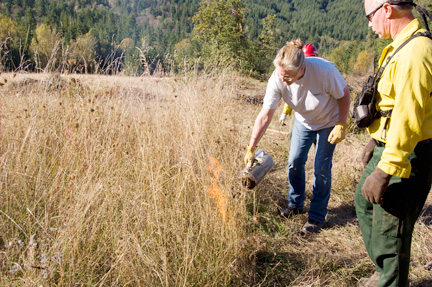
Gradually the grass was burned, make it safe to get the slash piles going. There were several that were pretty big. The wind was with us, just enough to keep the grass burning in the right direction, but not enough to let the embers fly off and “spot” into areas we didn’t want to catch on fire.
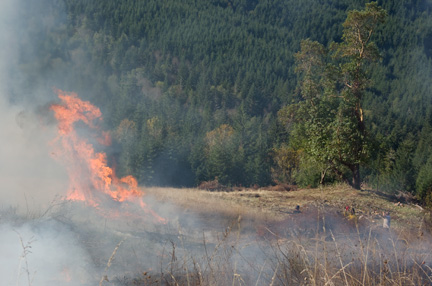
Watching the slash piles burn was pretty amazing. The fire is actually beautiful, but really, really hot … we had to stand quite a ways away!
Once the pile burned down, we continued with the grass, a bit at a time. In some areas the dried leaves and small branches under the trees would go up.
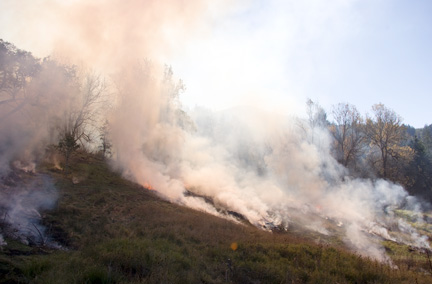
As the fire burned, it was easy to see how the natural order of things might be if a fire like this had been naturally caused by lightening. Even with brush on the ground, it just burned under the oaks.
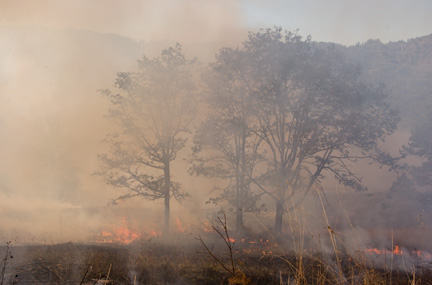
It wasn’t long before most of the fire had burned itself out, leaving a few smoking areas. Grass fires like this often don’t generate enough heat to catch the bigger trees on fire (which is why the oaks survive when the savannah burns). Even though there hasn’t been much rain so far, the moisture in the trees keeps them safe. In fact, we’re going to have to go back and handle some of the poison oak that didn’t burn (unfortunately!).
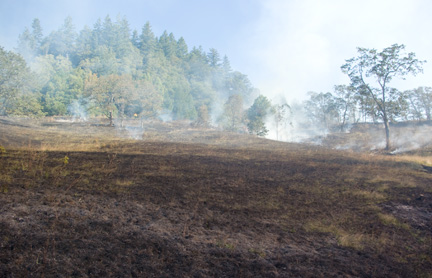
By midday most of the grass was pretty dry, but there’s a spring in the middle of the Oak Savannah, so there was underlying dampness that kept things from getting out of control. In fact, in some areas we couldn’t even really get the grass to burn. But we were very pleased with the final result.
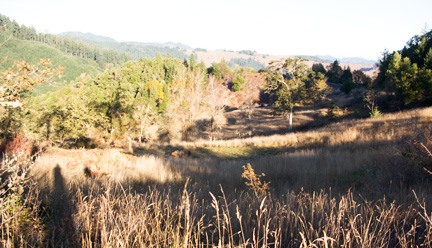
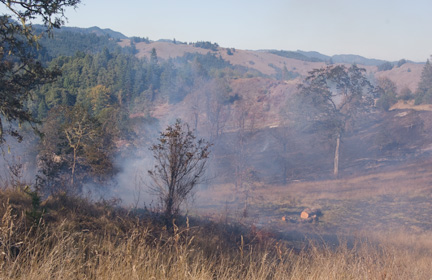
Several of our crew stayed up on the hill for several hours, monitoring the places still burning and making sure everything was safe. We still have some cleanup to do, particularly moving the unburned slash into new piles so we can try again with it. There are two areas that we didn’t attempt to burn this time because there was too much fuel and it would have been unsafe. The plan is to burn those next week, after the rains that are scheduled to come over the next few days.
Then this winter we’ll plant about 3,000 oak seedlings, watch the new grass come up in the spring and spend some time on the lookout for the elk, deer, cougar, coyote, bobcat, bear, and a host of smaller animals and birds that will likely be living in or moving through our Oak Savannah.
Leave a Reply